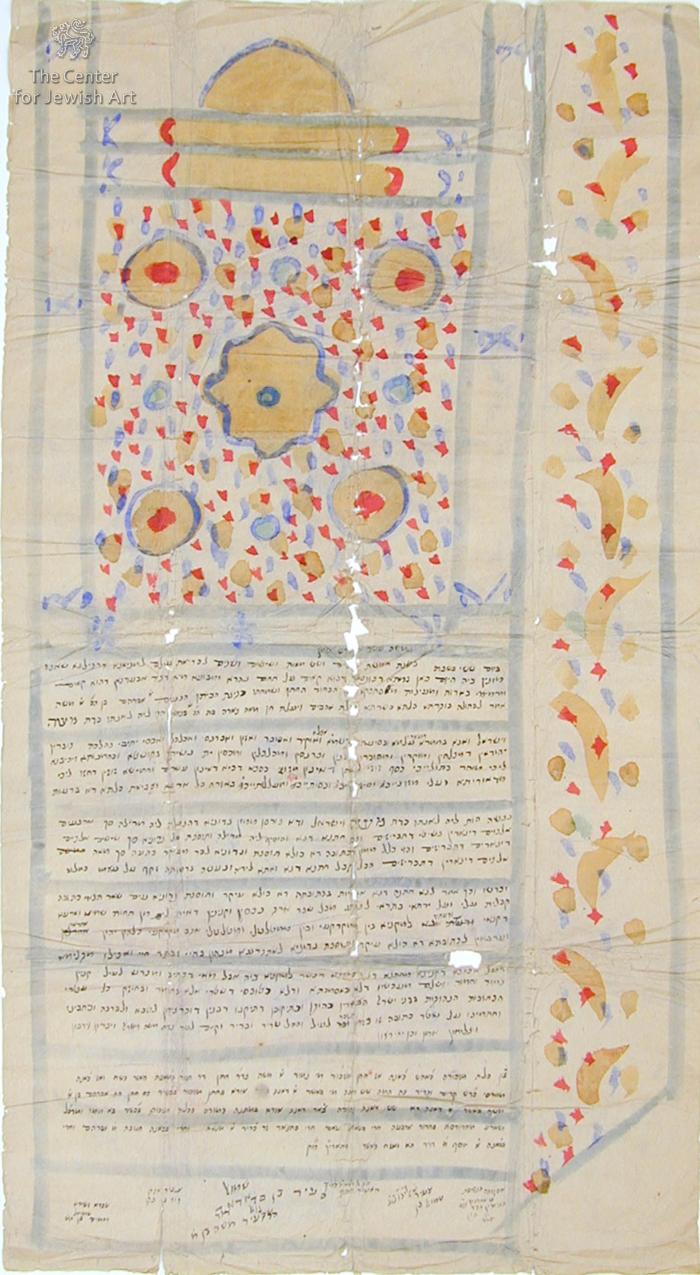Obj. ID: 48992
Hebrew Illuminated Manuscripts Ketubbah, Iran, 1902

The following description was prepared by William Gross:
In traditional Judaism, marriage is viewed as a contractual bond commanded by God in which a man and a woman come together to create a relationship in which God is directly involved. (Deut. 24:1) Though procreation is not the sole purpose, a Jewish marriage is traditionally expected to fulfill the commandment to have children. In this view, marriage is understood to mean that the husband and wife are merging into a single soul, which is why a man is considered "incomplete" if he is not married, as his soul is only one part of a larger whole that remains to be unified. There are many different stages and documents for the wedding.
A Ketubah (Hebrew: כְּתוּבָּה ; "written thing"; pl. Ketubot) is a special type of Jewish prenuptial agreement. It is considered an integral part of traditional Jewish marriage and outlines the rights and responsibilities of the groom, in relation to the bride. The content of the Ketubah is in essence a one-way contract that formalizes the various requirements by Halacha (Jewish law) of a Jewish husband vis à vis his wife. The Jewish husband takes upon himself in the Ketubah the obligation that he will provide to his wife three major things: clothing, food, and conjugal relations, and also that he will pay her a pre-specified amount of cash in the case of a divorce. Thus the content of the Ketubah essentially dictates security and protection for the woman, and her rights in the marriage.
This document is signed and then given to the bride as her property. In Italy and most of the Islamic countries in which Jews resided, such a Ketubah was often decorated, a tradition originating with the Jews in Spain. Today, generally, printed Ketubot are used.
This Ketubah was made and used in the city of Khusar, a most unusual and rare place from which to find such a document. In form, it is not dissimilar to the style of Ketubah from Teheran.
Groom: Avraham ben Moshe
Bride: Farah bat Binyamin
sub-set tree:
Sabar, Shalom, “The Illustrated Ketubbah in Iran,” in Haim Saadoun, ed., Jewish Communities in the East in the Nineteenth and Twentieth Century: Iran (Jerusalem: Ministry of Education and Ben-Zvi Institute, 2006), 187-194 (Hebrew), https://www.academia.edu/37491283/Shalom_Sabar_The_Illustrated_Ketubbah_in_Iran_in_Haim_Saadoun_ed_Jewish_Communities_in_the_East_in_the_Nineteenth_and_Twentieth_Century_Iran_Jerusalem_Ministry_of_Education_and_Ben_Zvi_Institute_2006_187_194_Hebrew_ (accessed June 11, 2023)


